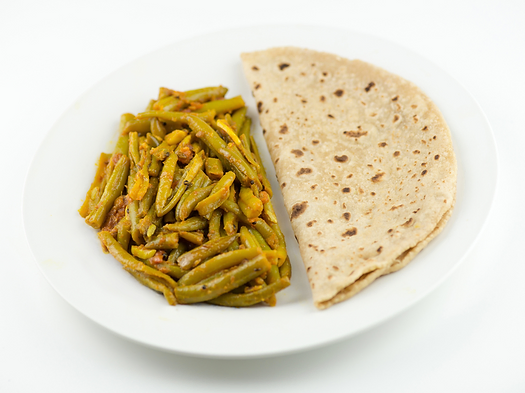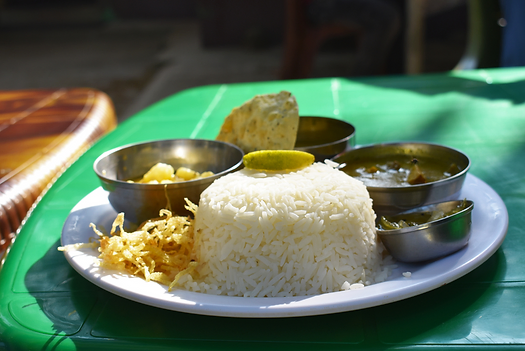Spice Chronicles: Exploring the Culinary Tapestry of Two Cultures
- Geetanjali Chakraborty
- Dec 15, 2023
- 4 min read
Updated: May 3, 2024
I am a descendant of India's partition, with one side of my family hailing from Pakistan and the other from Bangladesh, both having migrated during the 1947 partition. Growing up, I experienced the rich blend of cultures and cuisines from both regions. During Navaratri, I faced the delightful dilemma of choosing between the fasting cuisine of Northern India and the Bengali delicacies of Durga Puja.
My paternal grandparents, Dadu and Didu, were from Dhaka and Faridpur, Bangladesh, respectively. After their passing, my maternal grandparents, Papa and Mummy, who hailed from Dera Ismail Khan and Bahawalpur, Pakistan, came to live with us.
Our dining table was a mosaic of languages and cultures. When my paternal grandparents were alive, I conversed in Bangla with everyone except my mother, who I spoke to in Hindi, despite her fluency in Bangla with a Punjabi accent. With the arrival of my maternal grandparents, I observed my mother conversing with them in Punjabi, expanding my language understanding, although I don't speak it fluently.
Our dining table showcased a beautiful mix of Bengali and Punjabi cuisines, reflecting the diversity of our family's heritage. Personally, I've always had specific preferences when it comes to certain dishes.
In my mind, some foods just pair perfectly with roti/chapati, while others are meant for rice. Depending on my cravings for the day or the particular meal, I had the flexibility to indulge in either Bengali or Punjabi fare.
Both culinary traditions carry their unique spice profiles, but there's one foundational spice they both share: garam masala, which translates to "hot spice." While garam masala isn't hot in the chili sense, it does impart a warming quality to dishes, each culture infusing it with its own distinct twist.
The Bengali Garam Masala
Ingredients: Cardamom (elaichi), Clove (lavanga), and Cinnamon (dalchini)
These would be first dry roasted, then ground together, mixed in water and added on top of foods while they were being cooked.
Let's look at its properties.

The different texts give similar and diverse perspectives and we can interpret all of the commentaries as being a "yes, and". If we do, then we notice that all the five elements are present in the taste of the three spices. Taken together, all the doshas are alleviated. This is a somewhat involved Ayurvedic explanation that might explain why this combination has been used for a long time. These spices are very subtle in their nature. We should freshly roast and grind as they have volatile oils in them which release their flavors in the food being cooked, improving its digestibility through enhanced smell and taste.
The Punjabi Garam Masala
Ingredients: Cumin (jeera), Black pepper (gol mirich), Black Cardamom (badi elaichi), Green Cardamom (choti elaichi), Clove (lavanga) and Cinnamon (dalchini)
In our home, these would be dried in the sun instead of roasted. After drying, they would be ground. Alternatively, they can also be dry roasted and then ground. You will note that the Punjabi version is a superset of the Bengali version and adds on cumin, black cardamom and black pepper etc. Certain garam masalas would include bay leaf, nutmeg, whole red chilli etc. The customizations are endless. There is also a version of garam masala where the spices are not ground and are instead cooked whole in oil/ghee or dropped whole into food being cooked. This version is called 'khade masale'. If it is cooked in oil/ghee, right after the aroma emanates, food is added and cooked in it.
Garam masala is a spice combination that is customized to each household, especially the ones that like grinding their own spices. While this particular combination was used in my household by my mother and grandmother, I learned a different combination as a student of Ayurveda. Garam means "hot" and masala means "spice." This is called hot because it helps to break down heavier foods like meats, beans, etc. which are otherwise harder to digest. This spice mix makes it easier to digest when used in cooking.
In Winter and Spring, one can go easy and add it to various recipes on a daily basis as needed. The mix helps with generating heat in the food during winter, and as per the Ayurvedic texts, in Spring, it helps counter the kapha (mucus) in our body that has slowly started melting after the transition from Winter. Whereas, in other seasons like summer, this is best skipped because you want more of cooling spices to coincide with the weather.
When we make these mixes by hand, we engage with its healing properties as we know each ingredient at a personal level. We can modulate the spice level as per our liking and taste. This is quite different from buying store-made pre-packaged garam masala mixes. Those can never compete with the freshness of your hand-made garam masala.
I recommend making one batch freshly prepared and compare with a store-bought sample of garam masala so you can draw your own conclusion. In the last twenty years, I haven't bought over the counter pre-packaged masalas. Instead, I look up the recipe and modulate it to my taste. For instance, I omit red chillies because my system can't handle it. Personal customizations are very empowering for a family and gives us an opportunity to go beyond pre-conceived configurations of an entire cuisine.
Once you know your spices, you will be able to make your own version of chaat masala, a tangy spice mix that is famous in Indian street food. The predominant flavoring comes from four ingredients: roasted cumin powder, black salt, black pepper, and mango seed powder. Unlike garam masala which is used to cook foods, chaat masala is usually used on top of uncooked foods like salads and fruits. It is also often used on certain yogurt dishes.
India is known for its spices and every region has its own unique spices based on traditions, weather conditions, and what is locally available. I hope that reading this blog, you might be inspired to remember the flavors from your childhood and recreate for your family hand-made spice mixes that can be passed down.





